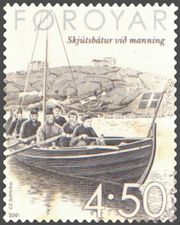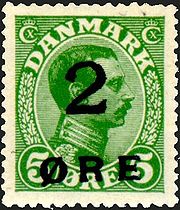
Postage stamps and postal history of the Faroe Islands
Encyclopedia
The postage stamps and postal history of the Faroe Islands began in the 1860s with a message exchange system called Skjúts, which was before a regular boat service was established between the islands. Postage is now under the control of Postverk Føroya
, the Postage Stamp Department of which has taken over all the work relating to Faroese postage stamps.
 Skjúts relied on a Skjútsskaffari (i.e., agent) being appointed in every village with the duty of organising a crew to transport people, letters or parcels from one village to another.
Skjúts relied on a Skjútsskaffari (i.e., agent) being appointed in every village with the duty of organising a crew to transport people, letters or parcels from one village to another.
The Skjúts system was actually introduced in around the mid-1860s, with the first Skjúts Act coming into force in 1865. Skjúts charges were laid down by the Løgting
, the Faroese Representative Council, for 5 years at a time. There were three types of Skjúts: official, clerical and private. The charges for Skjúts varied, with official being the cheapest and private the most expensive. There was no charge for Skjúts prior to 1865. All healthy males of between 15 and 50 years of age were liable for Skjúts duty: i.e., they could not refuse without incurring a fine. It was never an easy task to transport mail from one island to another across perilous waters where there were often powerful currents.
The Skjúts system existed until around World War I
, but was not used as much by then, as the Post Office's rates were relatively low and so represented a reasonable alternative.
 The first Faroese post office
The first Faroese post office
was opened in Tórshavn
on 1 March 1870. Others opened at Tvøroyri
and Klaksvík
on 1 March 1884 and 1 May 1888 respectively. The management of the post at all three was conducted by the local sýslumaður. These were the only Faroes post offices opened in the 19th century, but seven were opened in 1903 and, during the next twenty-five years, post offices were opened in essentially all of the settlements on the Faroes. 15 new offices were opened in 1918 alone.
 After the First World War, the Faroese Post Office was forced to use so-called provisional stamps. On 8 December 1918, the Post Office in Tórshavn received a message from Copenhagen
After the First World War, the Faroese Post Office was forced to use so-called provisional stamps. On 8 December 1918, the Post Office in Tórshavn received a message from Copenhagen
about the following increase of postal rates:
The increase in postal rates came into force on 1 January 1919.
Due to unreliable shipping connections, the supply of new 7-øre postage stamps failed to reach the Post Office in Tórshavn before 1 January 1919. When it became apparent that the increase in the postal rates would bring about a heavy demand for stamps amounting to 7 øre, and that the Faroese Post Offices´ stock of supplementary stamps, 1-, 2-, 3- and 4-øre, would not be sufficient to meet demand, special provisions had to be made. Thus the Post Office in Tórshavn received authorization to bisect the ordinary 4-øre stamps and use the individual halves as 2-øre stamps.
When the stock of 4-øre stamps began to run low, the Post Office was given authorization to overprint the required number of 5-øre stamps and use them as 2-øre stamps. For this purpose a hand stamp was made out of a wooden block bearing the letters "2 ØRE". Part of a chair leg was used as handle, and therefore the stamp was called the "chair leg stamp".
A similar situation arose in 1940–41. Following the German occupation of Denmark, the Faroes were under British administration from 12 April 1940 until the end of the Second World War in 1945. A shortage of Danish stamps was again resolved by the Post Office in Tórshavn overprinting the required number of stamps with a 20-øre surcharge.
Until 1 April 1976, the Faroese postal system was under the direction of Post Danmark
(Post and Telegraph System). At that time the Faroese postal system was organised so that it had a post office (Tórshavn Post Office) managed by a postmaster. Then came the postal clerks with the so-called postal agents as managers. The postal clerks were located in the following settlements: Klaksvík, Tvøroyri, Vágur
, Vestmanna
and Saltangará
. All the other post offices were divided into two groups. The larger ones were called "letter collection sites", and the smaller were called "postal exchange sites". Together with Tórshavn, these five post offices are still the main post offices.
 After the election for the Løgting
After the election for the Løgting
in November 1974, the government decided that the postal service in the Faroes should be taken over by the Faroese Home Rule. In 1975, the Danish government and the Faroese government began negotiations on the takeover issue. The results of these negotiations led to the Faroese government taking over the postal service in the Faroes as of 1 April 1976. This new institution received the name Postverk Føroya
(Post of the Faroes). A ram's horn was chosen as the institution's logo. As a natural consequence of the takeover, two new departments were established within the Faroese postal system: the Postage Stamp Department and the Post Office Giro.
Since the founding of Postverk Føroya in 1976, the Postage Stamp Department has taken over all the work relating to the postage stamps. The department organises all production, issuance and sales of postage stamps.
Work was being done on restructuring the Faroese postal system, with the intent being for Postverk Føroya, which was a public institution, to be reorganised into a type of joint-stock enterprise. The postal system however continued to be a public company.
Postverk Føroya
Posta is the postal service of the Faroe Islands and was founded on 1 April 1976 under the Home Rule of the Faroe Islands. On 16 December 2005, it became a public joint stock company under the name P/F Postverk Føroya ....
, the Postage Stamp Department of which has taken over all the work relating to Faroese postage stamps.
Skjúts

The Skjúts system was actually introduced in around the mid-1860s, with the first Skjúts Act coming into force in 1865. Skjúts charges were laid down by the Løgting
Løgting
Løgting is the unicameral parliament of the Faroe Islands, a self-ruling dependency of Denmark.The name literally means "Law Thing" - that is, a law assembly - and derives from Old Norse lǫgþing, which was a name given to ancient assemblies. A ting or Þing has existed on the Faroe Islands for over...
, the Faroese Representative Council, for 5 years at a time. There were three types of Skjúts: official, clerical and private. The charges for Skjúts varied, with official being the cheapest and private the most expensive. There was no charge for Skjúts prior to 1865. All healthy males of between 15 and 50 years of age were liable for Skjúts duty: i.e., they could not refuse without incurring a fine. It was never an easy task to transport mail from one island to another across perilous waters where there were often powerful currents.
The Skjúts system existed until around World War I
World War I
World War I , which was predominantly called the World War or the Great War from its occurrence until 1939, and the First World War or World War I thereafter, was a major war centred in Europe that began on 28 July 1914 and lasted until 11 November 1918...
, but was not used as much by then, as the Post Office's rates were relatively low and so represented a reasonable alternative.
First post offices

Post office
A post office is a facility forming part of a postal system for the posting, receipt, sorting, handling, transmission or delivery of mail.Post offices offer mail-related services such as post office boxes, postage and packaging supplies...
was opened in Tórshavn
Tórshavn
Tórshavn is the capital and largest town of the Faroe Islands. It is located in the southern part on the east coast of Streymoy. To the north west of the town lies the high mountain Húsareyn, and to the southwest, the high Kirkjubøreyn...
on 1 March 1870. Others opened at Tvøroyri
Tvøroyri
Tvøroyri lies picturesquely on the north side of the Trongisvágsfjørður on the east coast of Suðuroy, Faroe Islands....
and Klaksvík
Klaksvík
Klaksvík is the second largest town of the Faroe Islands.The town is located on Borðoy, which is one of the northernmost islands ....
on 1 March 1884 and 1 May 1888 respectively. The management of the post at all three was conducted by the local sýslumaður. These were the only Faroes post offices opened in the 19th century, but seven were opened in 1903 and, during the next twenty-five years, post offices were opened in essentially all of the settlements on the Faroes. 15 new offices were opened in 1918 alone.
Wartime stamp shortages
Danish stamps were in use from 1870, usually without any overprint or surcharge, until the first Faroese stamps were issued in 1975.
Copenhagen
Copenhagen is the capital and largest city of Denmark, with an urban population of 1,199,224 and a metropolitan population of 1,930,260 . With the completion of the transnational Øresund Bridge in 2000, Copenhagen has become the centre of the increasingly integrating Øresund Region...
about the following increase of postal rates:
- inland letters on the Faroes up to 250 grainGrain (measure)A grain is a unit of measurement of mass that is nominally based upon the mass of a single seed of a cereal. From the Bronze Age into the Renaissance the average masses of wheat and barley grains were part of the legal definition of units of mass. However, there is no evidence of any country ever...
(15 gGramThe gram is a metric system unit of mass....
) from 5 øre to 7 øre - postcards to Denmark up to 250 grainDanish units of measurementThe Danes started with a system of units based on a Greek pous of which they picked up through trade in the late Bronze Age/early Iron Age. Some early standards of measure can be recovered from measured drawings made of the , which though dating to the early Iron Age exemplifies plank built...
(15 g) from 4 øre to 7 øre
The increase in postal rates came into force on 1 January 1919.
Due to unreliable shipping connections, the supply of new 7-øre postage stamps failed to reach the Post Office in Tórshavn before 1 January 1919. When it became apparent that the increase in the postal rates would bring about a heavy demand for stamps amounting to 7 øre, and that the Faroese Post Offices´ stock of supplementary stamps, 1-, 2-, 3- and 4-øre, would not be sufficient to meet demand, special provisions had to be made. Thus the Post Office in Tórshavn received authorization to bisect the ordinary 4-øre stamps and use the individual halves as 2-øre stamps.
When the stock of 4-øre stamps began to run low, the Post Office was given authorization to overprint the required number of 5-øre stamps and use them as 2-øre stamps. For this purpose a hand stamp was made out of a wooden block bearing the letters "2 ØRE". Part of a chair leg was used as handle, and therefore the stamp was called the "chair leg stamp".
A similar situation arose in 1940–41. Following the German occupation of Denmark, the Faroes were under British administration from 12 April 1940 until the end of the Second World War in 1945. A shortage of Danish stamps was again resolved by the Post Office in Tórshavn overprinting the required number of stamps with a 20-øre surcharge.
The first Faroese stamps
In 1974–75, the Danish postal system began issuing Faroese postage stamps with the caption FØROYAR. The postal system used these stamps in the Faroes for franking mail and sold them to philatelists. The first Faroese postage stamps came on the market on 30 January 1975. From the first day they were available, the interest in Faroese postage stamps has been very extensive abroad. A number of times, postage stamps have been the second-largest source of export revenues for the Faroes.Until 1 April 1976, the Faroese postal system was under the direction of Post Danmark
Post Danmark
Post Danmark A/S is the company responsible for the Danish postal service. Established in 1995 following political liberalization efforts, it has taken over the mail delivery duties of the governmental department Postvæsenet ; it was turned into a public limited company in 2002...
(Post and Telegraph System). At that time the Faroese postal system was organised so that it had a post office (Tórshavn Post Office) managed by a postmaster. Then came the postal clerks with the so-called postal agents as managers. The postal clerks were located in the following settlements: Klaksvík, Tvøroyri, Vágur
Vágur
Vágur meaning Bay is a town on the Faroe Islands of Suðuroy, it is situated on the east coast of the island on the Vágsfjørður fjord, and dates from the fourteenth century. Expansion has meant that the nearby town of Nes is now a suburb of Vágur...
, Vestmanna
Vestmanna
Vestmanna is a town in the Faroe Islands on the west of the island of Streymoy. It was formerly a ferry port, until an undersea tunnel was built from Vágar to Kvívík and Stykkið. The cliffs west of Vestmanna, Vestmannabjørgini are very popular for excursions by boat.A 'Vestmann' was a "Westman",...
and Saltangará
Saltangará
Saltangará was founded in 1846 and is situated on the eastern side of Eysturoy Skalafjordur-inlet between Rituvík and Søldarfjørður....
. All the other post offices were divided into two groups. The larger ones were called "letter collection sites", and the smaller were called "postal exchange sites". Together with Tórshavn, these five post offices are still the main post offices.
Postverk Føroya

Løgting
Løgting is the unicameral parliament of the Faroe Islands, a self-ruling dependency of Denmark.The name literally means "Law Thing" - that is, a law assembly - and derives from Old Norse lǫgþing, which was a name given to ancient assemblies. A ting or Þing has existed on the Faroe Islands for over...
in November 1974, the government decided that the postal service in the Faroes should be taken over by the Faroese Home Rule. In 1975, the Danish government and the Faroese government began negotiations on the takeover issue. The results of these negotiations led to the Faroese government taking over the postal service in the Faroes as of 1 April 1976. This new institution received the name Postverk Føroya
Postverk Føroya
Posta is the postal service of the Faroe Islands and was founded on 1 April 1976 under the Home Rule of the Faroe Islands. On 16 December 2005, it became a public joint stock company under the name P/F Postverk Føroya ....
(Post of the Faroes). A ram's horn was chosen as the institution's logo. As a natural consequence of the takeover, two new departments were established within the Faroese postal system: the Postage Stamp Department and the Post Office Giro.
Since the founding of Postverk Føroya in 1976, the Postage Stamp Department has taken over all the work relating to the postage stamps. The department organises all production, issuance and sales of postage stamps.
Work was being done on restructuring the Faroese postal system, with the intent being for Postverk Føroya, which was a public institution, to be reorganised into a type of joint-stock enterprise. The postal system however continued to be a public company.

